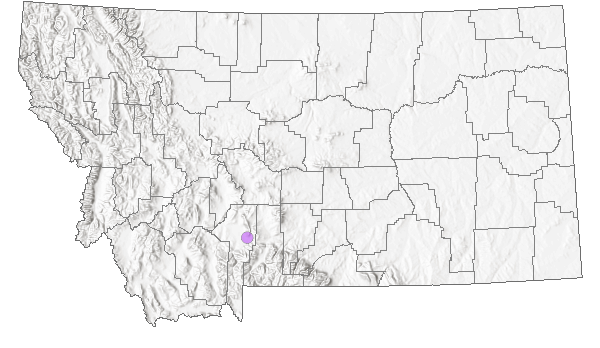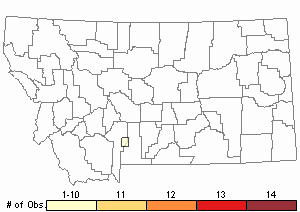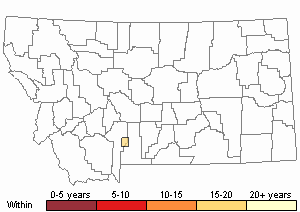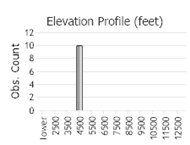View in other NatureServe Network Field Guides
NatureServe
Montana
Utah
Wyoming
Idaho
Wisconsin
British Columbia
South Carolina
Yukon
California
New York
Warm Spring Zaitzevian Riffle Beetle - Zaitzevia thermae
State Rank Reason (see State Rank above)
This riffle beetle is currently listed as "S1" in MT due to extremely limited and/or rapidly declining population numbers, range and/or habitat, making it highly vulnerable to global extinction or extirpation in the state. These warm-spring beetles are generally endemic to only a few locations; this species is endemic to 1 known location, a warm springs in the Bridger Creek Canyon outside of Bozeman.
General Description
A recent synopsis of Zaitzevia in North America (Brown 2001) concluded that Z. thermae was a subspecies of the more cosmopolitan Z. parvula on the basis of no difference between the two in genitalic morphology, and that other morphological differences (smaller length and width, reduced wings of Z. thermae) were consistent with those seen in other riffle beetle species between typical members in non-thermal locations and those inhabiting thermal springs. However, Brown (2001) also included the caveat that molecular or genetic evidence could support the taxonomic validity of Z. thermae as a full species. Apparently overlooked in the synopsis by Brown (2001) was the unpublished thesis by Hooten (1991), where electrophetic analysis segregated the two species and supported the status of Z. thermae at the full species level, even though Hooten (1991) also noted that the genitalia of the two species were indistinguishable.
[From Hatch 1938] "Length 2 mm.; piceous, the antennae, lergs, elytra, and apical portions of the abdomen paler; antennae short, eight-segmented, the funicle composed of a basal long and four very short segments, the last segment of the antennae forming a well marked club; pronotum widest at about basal fourth where it is nearly as wide as long, apex about seven eighths as wide as base, the sides somewhat arcuate; anterior angles of pronotum slightly prominent and acute, the posterior angles nearly rectangular; pronotal disc smooth, shining, sparsley coarsely puntuate and pubescent, with an opague longitudinal median impression occupying about or somewhat more than its median half, the region of the anterior angles opaque the lateral carinae of the pronotum, bordering an opaque impressed area on their median side; the median basal portion of the pronotum impressed, this impression more or less confluent with the median and lateral opaque impressions; elytra with about nine longitudinal series of punctures, corse at base, finer behind the middle, nearly obsolete towards apex; elytral intervals each set with a series of semierect setae, the fourth, sixth, and seventh intervals carinate, carinae crenulate on top, the fourth interval carinate froma bout basal sixth to beyond apical fourth, the sixthinterval carinate to beyond middle, the seventh interval carinate to beyond apical fourth, the carinae of the sixth and seventh intervals confluent for about basal seventh; the surface of the elytra latarad to the fourth interval sericeous except for a smooth humeral space; apex of elyta serrulate."
Phenology
Presumably adults active throughout the year.
Diagnostic Characteristics
Distinguished from all other elmids by a combination of 8-segmented antennae, pronotum with median longitudinal impression, lateral carinae of pronotum confined to basal 3/5, elytra sericeous laterad to 4th interval, terminal abdominal sternum pimply and rather narrowly biconic at apex, and male genitalia (aedeagus slender and clyndrical with parameres tighly appressed to penis) (Hatch 1938; Brown 2001); also genetic differences (see Hooten 1991).
Species Range
Montana Range
Range Descriptions

 Native
Native
Range Comments
Montana endemic: restricted to a small warm spring area at mouth of Bridger Canyon along Bridger Creek and Fish Hatchery road near Bozeman, at about 1518 m elevation in Gallatin County (Kindschi 1994). The habitat is owned by the federal government and lies on the Fish Technology Center property. Another riffle beetle, Brown's Microcylloepus Riffle Beetle (Microcylloepus browni) is endemic to warm water seeps 250-400 m downstream from where Z. thermae is found (Hooten 1991). Z. thermae occupies the same site, except it is limited to the upstream section of the warm spring.
Observations in Montana Natural Heritage Program Database
Number of Observations: 10
(Click on the following maps and charts to see full sized version)
Map Help and Descriptions
Relative Density

Recency



 (Observations spanning multiple months or years are excluded from time charts)
(Observations spanning multiple months or years are excluded from time charts)
Migration
Non-migratory. Restricted to a single location.
Habitat
Requires surface flowing warm water with temperatures between 60-84 deg. F; commonly found securely attached under rocks or clinging to watercress (Kindschi 1994). These beetles feed on small pieces of algae and diatoms that they scrape from submerged rocks on the gravel bottom and among vegetation. Both Z. thermae and M. browni require warm and flowing surface water with temperatures of 60 to 84° F. They are endemic to Bridger Creek Warm Springs near Bozeman, MT.
Food Habits
Uses mandibles for feeding on small pieces of algae and diatoms, scraping the food from rocks (Kindschi 1994).
Ecology
Adults are probably long-lived (>1 year); they are restricted in their dispersal capabilities by flightlessness and also by their requirement for warm and flowing surface water with temperatures of 60 to 84° F; it is likely, however, that mature larvae crawl out of the warm spring and pupate near its edge (Hooten 1991).
Reproductive Characteristics
Adults may be found in copulation most of the year, and the males cling tenaciously to their mates; it is likely that pupation occurs in late summer and early fall (Hooten 1991). Little is known of the reproduction habits of these beetles, but sexual reproduction of the adults likely occurs on cobbles during winter low water flow periods, and the females will lay eggs on these cobbles or adjacent vegetation.
Management
Zaitzevia thermae is a Montana Species of Concern because they are extremely locally distributed; 1 known spring site. They occupy limited spring or seepage habitat (total area=35 square meters) in and along Bridger Creek where it flows through the property of the U.S. Fish and Wildlife Service’s Bozeman Fish Technology Center at the mouth of Bridger Canyon, Montana. The globally rare (G1) ranking is largely due to the fact that this species is only found in a single locality.
Stewardship Responsibility
Threats or Limiting Factors
Restricted habitat, future human development upstream in the watershed could affect surface flows of this spring (Kindschi 1994). Specific threats to populations of Z. thermae and M. browni include habitat alteration from the development of warm water and surface water from Bridger Creek which may have adversely affected habitat; although specific impacts are not documented since water use began more than 100 years ago. Upstream land use activities have potential to become a threat but are not known to be a problem at this time aside from some detectable sedimentation.
References
- Literature Cited AboveLegend:
 View Online Publication
View Online Publication Hooten, M.M. 1991. Biological systematics of Zaitzevia thermae (Hatch). M.Sc. Thesis. Bozeman, MT: Montana State University. 88 p.
Hooten, M.M. 1991. Biological systematics of Zaitzevia thermae (Hatch). M.Sc. Thesis. Bozeman, MT: Montana State University. 88 p. Kindschi, G. 1994. Memorandum: Draft beetle conservation management plan and update on recent activities. FWS Fish Technology Center, Bozeman, Montana. 10 pp plus tables.
Kindschi, G. 1994. Memorandum: Draft beetle conservation management plan and update on recent activities. FWS Fish Technology Center, Bozeman, Montana. 10 pp plus tables.
- Additional ReferencesLegend:
 View Online Publication
View Online Publication
Do you know of a citation we're missing? Brown, H.P. 2001. Synopsis of the riffle beetle genus Zaitzevia (Coleoptera: Elmidae) in North America, with description of a new subgenus and species. Entomological News 112:201-211.
Brown, H.P. 2001. Synopsis of the riffle beetle genus Zaitzevia (Coleoptera: Elmidae) in North America, with description of a new subgenus and species. Entomological News 112:201-211. Hatch, M. H. 1938. Description of two new riffle beetles. Entomological News 49:16-19.
Hatch, M. H. 1938. Description of two new riffle beetles. Entomological News 49:16-19. Hatch, M. H. 1938. Two new species of Helmidae from a Warm Spring in Montana. (Coleoptera). Entomol. News 49:16-19
Hatch, M. H. 1938. Two new species of Helmidae from a Warm Spring in Montana. (Coleoptera). Entomol. News 49:16-19 Krise, William, Mark Wilson, Chris Hunter and Daniel Gustafson. 2006. Conservation agreement and strategy for Thermae Riffle Beetle (Zaitzeva thermae) and Brown's Riffle Beetle (Microcylloepus browni) at the Bozeman Fish Technology Center, Bozeman, Montana.
Krise, William, Mark Wilson, Chris Hunter and Daniel Gustafson. 2006. Conservation agreement and strategy for Thermae Riffle Beetle (Zaitzeva thermae) and Brown's Riffle Beetle (Microcylloepus browni) at the Bozeman Fish Technology Center, Bozeman, Montana.
- Web Search Engines for Articles on "Warm Spring Zaitzevian Riffle Beetle"
- Additional Sources of Information Related to "Insects"





